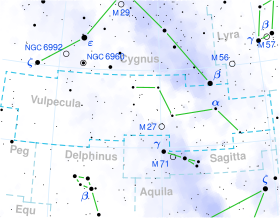31 Vulpeculae
| Observation data Epoch J2000 Equinox J2000 | |
|---|---|
| Constellation | Vulpecula |
| Right ascension | 20h 52m 07.68352s[1] |
| Declination | 27° 05′ 48.9951″[1] |
| Apparent magnitude (V) | 4.56[2] |
| Characteristics | |
| Evolutionary stage | horizontal branch |
| Spectral type | G7IIIa Fe-1 Ba[2] |
| U−B color index | +0.46[3] |
| B−V color index | +0.82[3] |
| Variable type | suspected[4] |
| Astrometry | |
| Radial velocity (Rv) | +2.25[5] km/s |
| Proper motion (μ) | RA: −70.902[1] mas/yr Dec.: −56.360[1] mas/yr |
| Parallax (π) | 14.2796 ± 0.1864 mas[1] |
| Distance | 228 ± 3 ly (70.0 ± 0.9 pc) |
| Absolute magnitude (MV) | 0.77[6] |
| Orbit[7] | |
| Period (P) | 1,860.6±1.3 d |
| Semi-major axis (a) | ≥ 103.0 Gm |
| Eccentricity (e) | 0.375±0.009 |
| Periastron epoch (T) | 52,316±6 MJD |
| Argument of periastron (ω) (secondary) | 15.1±1.4° |
| Semi-amplitude (K1) (primary) | 4.34±0.04 km/s |
| Details[8] | |
| 31 Vul A | |
| Mass | 2.40±0.05 M☉ |
| Radius | 8.01±0.30 R☉ |
| Luminosity | 52.53[2] L☉ |
| Surface gravity (log g) | 2.97±0.05 cgs |
| Temperature | 5,261±15 K |
| Metallicity [Fe/H] | −0.05±0.02 dex |
| Rotational velocity (v sin i) | 5.9±0.3[7] km/s |
| Age | 700±40 Myr |
| Other designations | |
| Database references | |
| SIMBAD | data |
31 Vulpeculae is a binary star[7] system in the northern constellation of Vulpecula. It is visible to the naked eye as a faint, yellow-hued point of light with an apparent visual magnitude of 4.56.[2] The system is located approximately 228 light years away from the Sun based on parallax,[1] and it is drifting further away with a radial velocity of +2.25 km/s.[5]
The variable radial velocity of this system was first suspected by German Astronomer Friedrich Küstner in 1914. The system appears as a single-lined spectroscopic binary with an orbital period of 5.1 years and an eccentricity of 0.38. The a sin i value for the primary is 103.0 ± 1.1 Gm (0.69 ± 0.01 AU),[7] where a is the semimajor axis and i is the (unknown) orbital inclination. This value provides a lower bound on the actual semimajor axis for the orbit.
The primary component is an aging giant star with a stellar classification of G7IIIa Fe-1 Ba,[2] indicating a mild barium star with an underabundance of iron.[7] Having exhausted the supply of hydrogen at its core, it has expanded to eight times the Sun's radius.[8] It is a red clump giant,[10] which indicates it is on the horizontal branch and is generating energy through helium fusion at its core. This is a suspected variable star with a magnitude that varies from 3.77 to 4.08 in the I passband.[4] It is about 700 million years old with 2.4 times the mass of the Sun. The star is radiating 53[2] times the luminosity of the Sun from its enlarged photosphere at an effective temperature of 5,261 K.[8] The companion may be a degenerate white dwarf with about 0.4 M☉.[7]
References
[edit]- ^ a b c d e f Brown, A. G. A.; et al. (Gaia collaboration) (August 2018). "Gaia Data Release 2: Summary of the contents and survey properties". Astronomy & Astrophysics. 616. A1. arXiv:1804.09365. Bibcode:2018A&A...616A...1G. doi:10.1051/0004-6361/201833051. Gaia DR2 record for this source at VizieR.
- ^ a b c d e f Anderson, E.; Francis, Ch. (2012). "XHIP: An extended hipparcos compilation". Astronomy Letters. 38 (5): 331. arXiv:1108.4971. Bibcode:2012AstL...38..331A. doi:10.1134/S1063773712050015. S2CID 119257644. Vizier catalog entry
- ^ a b Mallama, A. (2014). "Sloan Magnitudes for the Brightest Stars". The Journal of the American Association of Variable Star Observers. 42 (2): 443. Bibcode:2014JAVSO..42..443M.Vizier catalog entry
- ^ a b Samus, N. N.; Durlevich, O. V.; et al. (2009). "General Catalogue of Variable Stars". VizieR On-line Data Catalog: B/GCVS. Originally Published in: 2009yCat....102025S. 1. Bibcode:2009yCat....102025S.
- ^ a b Soubiran, C.; Bienaymé, O.; Mishenina, T. V.; Kovtyukh, V. V. (2008). "Vertical distribution of Galactic disk stars". Astronomy and Astrophysics. 480 (1): 91–101. arXiv:0712.1370. Bibcode:2008A&A...480...91S. doi:10.1051/0004-6361:20078788. S2CID 16602121.
- ^ Da Silva, Ronaldo; et al. (2015). "Homogeneous abundance analysis of FGK dwarf, subgiant, and giant stars with and without giant planets". Astronomy & Astrophysics. 580: A24. arXiv:1505.01726. Bibcode:2015A&A...580A..24D. doi:10.1051/0004-6361/201525770. S2CID 119216425. Vizier catalog entry
- ^ a b c d e f Griffin, R. F. (August 2009). "Spectroscopic binary orbits from photoelectric radial velocities. Paper 207: 58 Piscium, 31 Vulpeculae, and 70 Pegasi". The Observatory. 129: 198–218. Bibcode:2009Obs...129..198G.
- ^ a b c Maldonado, J.; Villaver, E. (April 2016). "Evolved stars and the origin of abundance trends in planet hosts". Astronomy & Astrophysics. 588: 11. arXiv:1602.00835. Bibcode:2016A&A...588A..98M. doi:10.1051/0004-6361/201527883. S2CID 119212009. A98.
- ^ "31 Vul". SIMBAD. Centre de données astronomiques de Strasbourg. Retrieved 2019-07-13.
- ^ Alves, David R. (August 2000), "K-Band Calibration of the Red Clump Luminosity", The Astrophysical Journal, 539 (2): 732–741, arXiv:astro-ph/0003329, Bibcode:2000ApJ...539..732A, doi:10.1086/309278, S2CID 16673121
External links
[edit]- 31 Vulpeculae on WikiSky: DSS2, SDSS, GALEX, IRAS, Hydrogen α, X-Ray, Astrophoto, Sky Map, Articles and images


